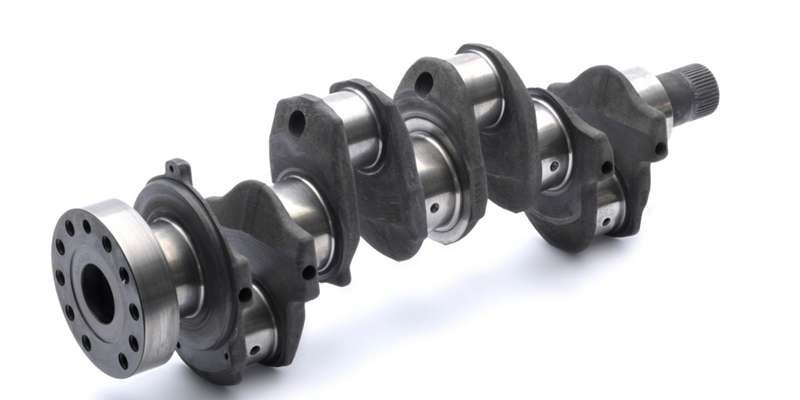The crankshaft is a critical component of a car’s engine, responsible for converting the linear motion of pistons into rotational motion that ultimately powers the wheels. Understanding its function, components, and various types is essential for anyone interested in car mechanics. This guide provides a detailed overview of the crankshaft, addressing its working mechanism, different types, key components, manufacturing process, and factors influencing replacement costs.
How a Crankshaft Works: From Piston to Power
The crankshaft’s operation relies on a series of interconnected parts working in harmony. Here’s a breakdown of the process within a four-stroke engine:
1. Piston’s Downward Motion: The piston moves down from the top dead center (TDC) to the bottom dead center (BDC). This linear motion is transferred to the crankshaft via a connecting rod.
2. Motion Transformation: The crankshaft converts the reciprocating motion of the piston into rotational motion. This rotational force is then transmitted to the camshaft.
3. Compression: The camshaft opens the intake valve, allowing the air-fuel mixture into the combustion chamber. The piston moves back up to TDC, compressing the mixture. The camshaft then closes the intake and exhaust valves. This completes one crankshaft revolution.
4. Ignition: The spark plug ignites the compressed mixture, forcing the piston down in a power stroke. This downward force is again transferred to the crankshaft.
5. Flywheel Motion: The crankshaft’s rotational motion spins the flywheel, which stores energy and smooths out the engine’s power delivery. This stored energy helps maintain consistent rotation and powers the vehicle’s wheels.
6. Exhaust Stroke: The piston moves back up to TDC, pushing the exhaust gases out through the open exhaust valve. The camshaft controls the timing of the exhaust valve opening and closing.
Different Types of Crankshafts
Crankshafts are categorized based on their manufacturing process and construction:
1. Fully Built Shaft: Assembled from individual components (crankpin, main journals, crank web) that are machined and shrink-fitted together.
2. Welded Shaft: Created by welding the main journals to the crankpin and web using submerged arc welding. Often features thinner crank webs.
3. Forged Crankshaft: Manufactured using a die under high pressure, resulting in a strong and durable crankshaft with excellent dimensional stability. Commonly used in high-performance engines.
4. Solid Single Piece Crankshaft: Made from a single piece of metal, either through forging or casting. Designed to withstand significant stress but susceptible to vibrations.
5. Billet Crankshaft: Machined from a solid block of high-quality steel alloy. Offers excellent strength and requires minimal balancing.
6. Cast Crankshaft: Made by pouring molten iron into a mold. Cost-effective and machinable, suitable for various petrol and diesel engines.
7. Semi-Built Shaft: Crank webs are forged and shrink-fitted to the main bearings, while the crankpins are machined for a smooth finish. Lighter than fully built crankshafts.
Key Components of a Crankshaft
A crankshaft consists of several vital components:
- Main Journals: Provide support and allow the crankshaft to rotate within the engine block.
- Counterweights: Balance the rotating assembly and reduce vibrations.
- Flywheel Mounting Flange: Connects the crankshaft to the flywheel.
- Crank Pins: Connect the connecting rods to the crankshaft, transferring the piston’s linear motion.
- Crank Webs: Connect the main journals and crank pins, providing structural support.
- Thrust Washers: Limit axial movement of the crankshaft.
- Oil Seals: Prevent oil leakage from the engine.
Crankshaft Manufacturing: Casting and Forging
Crankshafts are primarily manufactured using two methods:
- Casting: Molten metal (usually cast iron) is poured into a mold to create the desired shape.
- Forging: A solid block of steel is heated and shaped under immense pressure, resulting in a stronger, more durable crankshaft.
Crankshaft Replacement Cost Factors
Several factors influence the cost of replacing a crankshaft:
- Labor Cost: Removing and replacing a crankshaft is labor-intensive, requiring significant time and expertise.
- Engine Condition: Damaged engine components often necessitate replacement alongside the crankshaft, increasing the overall cost.
- Crankshaft Cost: OEM crankshafts are typically more expensive than aftermarket options, especially for less common or luxury vehicles.
Conclusion
The crankshaft is an integral part of a combustion engine, playing a crucial role in converting reciprocating motion into rotational power. Understanding its function, components, and the various types available is essential for car enthusiasts and mechanics alike. This knowledge enables informed decisions regarding maintenance and repairs, ultimately contributing to the longevity and performance of a vehicle.

